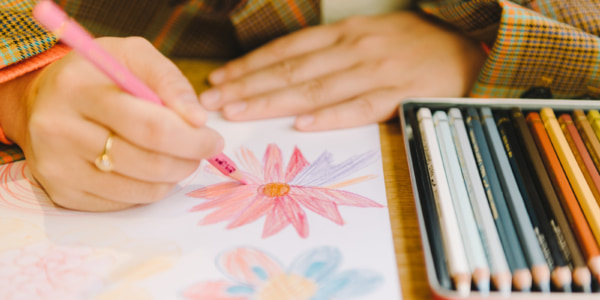Breaking free from a life of waiting
PICFA is a part of the Welfare Service Office for People with Disabilities, Medical Corporation Seimeikai, located in Saga Prefecture. Yasunaga is more punctual than anyone else here. There’s a morning assembly at 10:00 a.m. and lunch at 12:00 noon, and he hates to be late even by a second. He is a man who lives by the clock.
![[Photograph]](https://staging2022.diversity-in-the-arts.jp/admin/wp-content/uploads/2023/02/img_yasunaga-03.jpg)
Though Yasunaga was focused on his work, he paused and struck a pose when we spoke to him.
HARADA Hiroyuki, the president of PICFA, told us about the time he first met Yasunaga. “Back then, he was working as a kitchen assistant at a welfare facility, but even then there wasn’t much work that he could do.” Yasunaga was told to “wait a bit,” and he ended up waiting for hours. He spent every day, day after day, doing nothing but waiting. His family became unable to bear the thought that their son would spend his entire life in limbo. They came to PICFA, and said, “If possible, we’d like him to come here regularly.”
![[Photograph]](https://staging2022.diversity-in-the-arts.jp/admin/wp-content/uploads/2023/02/img_yasunaga-04.jpg)
Some of the talkative characters created by Yasunaga.
However, according to his parents, Yasunaga didn’t have much experience in painting. If Yasunaga showed up at PICFA and did nothing but sit in a chair and wait for time to pass, that would be just as miserable for him, and not much different from working at a job that didn’t fit him.
![[Photograph]](https://staging2022.diversity-in-the-arts.jp/admin/wp-content/uploads/2023/02/img_yasunaga-05.jpg)
Yasunaga carefully checks to make sure every surface has been covered with paint.
“What matters is whether or not he enjoys painting. PICFA won’t accept him if he doesn’t want to express himself.”
Thus, Yasunaga was asked to spend two weeks in hands-on practice at PICFA. Though he said he had never painted before, as soon as he was given some paint, he began to use it without hesitation. From the very beginning, he seemed to have already established his own style of painting. “He’s amazing,” Harada commented.
“This is just a hypothesis,” says Harada, “but people with autism sometimes have difficulty with speech or converse using one-word sentences. To compensate, they may have been using visual elements such as illustrations to communicate with others from childhood. Even if they have had no prior experience with painting before, they may be able to naturally translate the world they see into pictures. Yasunaga might disagree with me on this, though!” (Laughs.)
![[Photograph]](https://staging2022.diversity-in-the-arts.jp/admin/wp-content/uploads/2023/02/img_yasunaga-07.jpg)
Yasunaga uses only a few colors in his paintings. His style is to prepare the colors, then apply them with care.
As Yasunaga continued to paint dispassionately, Harada asked him, “Are you having fun?” It’s an important question for Harada. Yasunaga answered, with a blank expression on his face, that he was having fun. Harada, however, said that he saw determination in Yasunaga’s blank look.
“It’s just my feeling, but when Yasunaga said the word ‘fun,’ I saw a sort of determination in him to keep going with this.”
Rich emotions in an expressionless face
![[Photograph]](https://staging2022.diversity-in-the-arts.jp/admin/wp-content/uploads/2023/02/img_yasunaga-08.jpg)
Taciturn Yasunaga with his talkative character.
There’s not much variation in the faces of the characters that Yasunaga paints. The only features distinguishing one from another are that men have thick eyebrows, and women have eyelashes. However, if you look at the paintings closely, you begin to see their facial expressions. Some of them look as if they are smiling, even though they are not, while others look as if they are deep in thought.
“His paintings are actually very expressive,” says Harada. “That’s where I feel the fullness of his heart.”
![[Photograph]](https://staging2022.diversity-in-the-arts.jp/admin/wp-content/uploads/2023/02/img_yasunaga-09.jpg)
Yasunaga paints fashionable characters.
As mentioned above, Yasunaga is strict about time. If Harada doesn’t start the morning assembly as scheduled or if lunch is delayed, Yasunaga reminds him: “It’s time.”
![[Photograph]](https://staging2022.diversity-in-the-arts.jp/admin/wp-content/uploads/2023/02/img_yasunaga-10.jpg)
Yasunaga deep in concentration. He seems quietly immersed in his own world.
Sometimes, Harada ignores these reminders. When he does, Yasunaga goes up to him and repeats, “It’s time!” He will say this again and again. But sometimes Harada still ignores it. Of course, his intention is not to be mean. It is to have Yasunaga experience that “schedules can change,” so that he can learn to be more flexible about time within himself.
![[Photograph]](https://staging2022.diversity-in-the-arts.jp/admin/wp-content/uploads/2023/02/img_yasunaga-11.jpg)
Yasunaga looking happy, and Harada examining his work
“For example, we sometimes do live painting events on a large stage. During an event like this, he may not be able to eat meals at a set time. When he’s traveling, his train or plane may be delayed. You never know what will happen in the outside world. But if he has the flexibility to delay meals and breaks by an hour each, at the end of the day he will have the ability to change his schedule by a total of several hours a day. This would also help his parents. Above all, I don’t want them to see Yasunaga on a big stage, caught up on what time it is. I want them to see Yasunaga looking really good. This work will help to expand Yasunaga’s life.”
![[Photograph]](https://staging2022.diversity-in-the-arts.jp/admin/wp-content/uploads/2023/02/img_yasunaga-12.jpg)
Yasunaga paints single-mindedly.
When I looked at Yasunaga, he was single-mindedly painting a vibrant picture, his large figure hunched over in front of his desk. Yasunaga is a large, quiet man. Instead of talking, he lets his paintings speak. And speak they do. Perhaps it is our power as the viewers of his paintings that allows us to hear what they are saying.


![[Photograph]](https://staging2022.diversity-in-the-arts.jp/admin/wp-content/uploads/2023/02/img_yasunaga-01.jpg)
![[Works]](https://staging2022.diversity-in-the-arts.jp/admin/wp-content/uploads/2023/02/img_yasunaga-02a.jpg)
![[Works]](https://staging2022.diversity-in-the-arts.jp/admin/wp-content/uploads/2023/02/img_yasunaga-02b.jpg)
![[Works]](https://staging2022.diversity-in-the-arts.jp/admin/wp-content/uploads/2023/02/img_yasunaga-02c.jpg)
![[Works]](https://staging2022.diversity-in-the-arts.jp/admin/wp-content/uploads/2023/02/img_yasunaga-02d.jpg)
![[Photograph]](https://staging2022.diversity-in-the-arts.jp/admin/wp-content/uploads/2023/02/img_yasunaga-06a.jpg)
![[Photograph]](https://staging2022.diversity-in-the-arts.jp/admin/wp-content/uploads/2023/02/img_yasunaga-06b.jpg)

